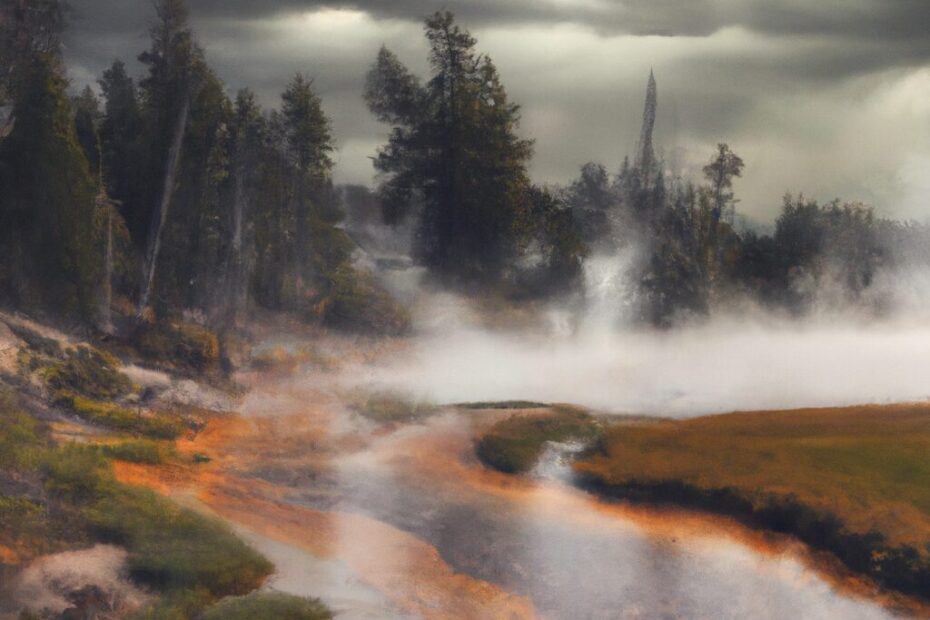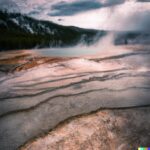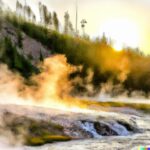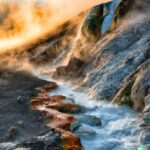Yellowstone National Park is home to some of the most stunning geysers in the world, drawing visitors from far and wide to witness these natural wonders.
But how are geysers formed, and why is Yellowstone famous for them? In this article, we’ll explore the conservation efforts being made to protect these geysers, as well as the threats they face.
From monitoring geyser activity to educating visitors, there are many steps being taken to ensure the preservation of these incredible natural phenomena. So, let’s dive in and discover what we can do to help conserve Yellowstone geysers.
What Are Geysers?
Geysers are natural geological formations that are characterized by intermittent hot water and steam eruptions, often accompanied by vibrant displays of color and mineral deposits.
These mesmerizing thermal features are a result of underground water reservoirs being heated by the Earth’s magma, causing the water to reach boiling point and creating pressure.
When the pressure becomes strong enough, the superheated water and steam burst through the surface, creating the spectacular eruptions that we associate with geysers. Yellowstone National Park is renowned for its diverse array of geysers, with the most famous being Old Faithful, captivating visitors with its predictably regular eruptions and remarkable beauty. The geothermal activity in Yellowstone continuously shapes and evolves the landscape, making it a captivating geological wonder.
How Do Geysers Form?
The formation of geysers is intricately linked to the presence of geothermal activity, particularly in regions with volcanic systems such as Yellowstone National Park.
Geysers are formed through a combination of underground water reservoirs, heat, and unique geological structures. The geothermal activity beneath the Earth’s surface heats groundwater, creating immense pressure.
As the pressure builds, the water is forced upward through fractures in the Earth’s crust, finding its way to the surface. The volcanic systems in places like Yellowstone provide the intense heat necessary for this process. The unique geological makeup of Yellowstone, with its hotspots and magma chambers, plays a crucial role in geyser formation.
What Is Yellowstone National Park?
Yellowstone National Park, established in 1872, is a renowned and expansive natural reserve dedicated to the preservation of diverse ecosystems, fostering ecological balance, and promoting environmental stewardship.
Spanning over 2.2 million acres across the states of Wyoming, Montana, and Idaho, Yellowstone National Park is one of the largest and most iconic national parks in the United States.
Aside from its impressive size, Yellowstone also boasts unique geological features, including geysers, hot springs, and the famous Old Faithful geyser. It is also home to a diverse range of wildlife, such as grizzly bears, wolves, and herds of bison.
What sets Yellowstone apart is its commitment to preserving its natural habitats and promoting sustainable practices. This makes it an essential cornerstone of environmental conservation efforts.
Why Is Yellowstone Famous For Its Geysers?
Yellowstone is renowned for its geysers due to the park’s unwavering commitment to conservation, preservation, and sustainable management, which has allowed for the ecological restoration and continued prominence of these natural thermal features.
The park’s dedication to conservation and sustainable management practices has safeguarded the delicate balance necessary for the preservation of its unique geothermal wonders.
Through ongoing initiatives for ecological restoration, Yellowstone has nurtured the environment in a way that ensures the longevity and vitality of its geysers, contributing to the park’s global fame as a natural marvel. This commitment to responsible stewardship has set a remarkable example for other natural reserves worldwide.
What Are The Conservation Efforts For Yellowstone Geysers?
The conservation efforts for Yellowstone geysers are multifaceted, encompassing vigilant park management, ecological restoration projects, and the promotion of sustainable tourism practices to ensure the long-term preservation of these remarkable natural wonders.
Management strategies play a pivotal role in preserving the delicate balance of the geothermal features within the park. These strategies include strict regulations on visitor access and designated boardwalks to minimize human impact. Ongoing monitoring is also conducted to detect any changes in geyser behavior.
The park actively engages in ecological restoration projects to rehabilitate areas affected by human interference. This includes the restoration of vegetation and habitat for native wildlife. Additionally, sustainable tourism initiatives, such as educating visitors on responsible behavior and promoting eco-friendly transportation, further contribute to the protection of Yellowstone’s geysers.
Monitoring Geyser Activity
The monitoring of geyser activity in Yellowstone is a crucial aspect of conservation efforts. It enables park management to assess environmental impact, detect changes, and implement necessary interventions to safeguard these natural thermal features.
By continuously monitoring the geysers, park management can gauge the health of the geothermal system. This allows for identification of any variations in activity that may be indicative of underlying geological or environmental shifts. This information is invaluable for conservation purposes as it allows for proactive measures to be taken to preserve the delicate balance of these unique natural phenomena.
Utilizing methods such as seismic monitoring, remote sensing, and water chemistry analysis provides valuable data that assists in the ongoing management and protection of these geothermal areas.
Controlling Human Impact
Controlling human impact on Yellowstone’s geysers is essential for conservation efforts, as it involves mitigating human interference, preserving environmental protection, and safeguarding cultural resources associated with these natural wonders.
Measures such as carefully designated boardwalks and trails guide visitors around the fragile thermal areas, reducing the risk of inadvertent damage.
Educational programs and signage impart the significance of responsible behavior and the need to respect the geothermal features. Strict regulations are in place to limit the development and expansion of infrastructure near the geysers, ensuring their natural state is preserved for future generations to appreciate and enjoy.
Managing Geothermal Energy Use
The management of geothermal energy use in Yellowstone is a critical component of conservation efforts, focusing on sustainable management practices and the responsible utilization of geothermal resources to minimize the impact on the park’s thermal features.
Implementing sustainable strategies involves monitoring and controlling the extraction of geothermal fluids, while promoting renewable energy technologies.
By integrating responsible geothermal energy use, Yellowstone aims to preserve the natural balance of its geysers and hot springs. This includes educating visitors about the significance of geothermal conservation and supporting ongoing research into sustainable geothermal utilization.
Careful planning and zoning help regulate geothermal developments while safeguarding the unique geological and hydrothermal features of the park.
Educating Visitors About Geysers
Educating visitors about geysers at Yellowstone is pivotal for conservation, as it fosters a deeper understanding of sustainable tourism practices, promotes ecosystem health, and encourages responsible behavior to minimize the environmental impact on these natural thermal features.
By providing educational materials and guided tours, visitors can learn how to appreciate the geothermal wonders while taking measures to preserve their natural beauty.
Understanding the delicate balance of geothermal ecosystems helps visitors to make informed decisions and contribute to the protection of these unique natural formations. This knowledge empowers individuals to engage in responsible conduct, such as staying on designated paths and following specified guidelines to minimize their environmental footprint and maintain the ecological integrity of these sensitive areas.
What Are The Threats To Yellowstone Geysers?
The geysers at Yellowstone face various threats, including the impacts of climate change, human interference, and potential challenges arising from geothermal energy extraction within the park’s vicinity.
Climate change poses a significant threat to the delicate balance of heat and water that sustains the geysers. As temperatures rise, the intricate underground plumbing systems that deliver water to the geysers could be disrupted, altering their eruption patterns.
Human interference, such as vandalism or altering the natural flow of geothermal features, can also have detrimental effects. The extraction of geothermal energy near Yellowstone could lead to a reduction in the heat and water resources that power these natural wonders, impacting their longevity and stability.
Climate Change
The effects of climate change pose a significant threat to the conservation of Yellowstone’s geysers, impacting the ecological balance and overall ecosystem health within the park.
Rising temperatures and altered precipitation patterns directly influence the geothermal features of Yellowstone. Increased temperatures can lead to changes in geyser activity, potentially altering the delicate balance of the ecosystem.
For instance, reduced water availability due to altered precipitation may affect the flow and pressure of geysers. These changes can disrupt the habitat of unique microbial life around the geysers, impacting the entire food chain within the park’s ecosystem. Consequently, conservation efforts face a daunting task in preserving the natural balance and biodiversity of this remarkable natural wonder.
Human Interference
Human interference presents a significant challenge to the conservation of Yellowstone’s geysers, as it can lead to adverse environmental impacts and hinder the preservation of these natural thermal features.
The introduction of foreign objects into the geysers, such as coins, rocks, or trash, disrupts their delicate balance, affecting their eruption patterns and potentially causing long-term damage.
Human activity near the geysers can lead to soil erosion and habitat destruction for the unique flora and fauna that thrive in these thermal environments, further threatening the biodiversity of the area.
Efforts to ensure minimal human interference are crucial to safeguarding the ecological integrity of Yellowstone’s geysers and the surrounding ecosystem.
Geothermal Energy Extraction
The potential for geothermal energy extraction near Yellowstone poses challenges to the sustainable management and environmental stewardship required for the conservation of the park’s geysers.
The utilization of geothermal energy presents an opportunity for renewable energy sources and reducing greenhouse gas emissions. However, it also raises concerns about the potential impact on the delicate ecosystem of Yellowstone National Park.
Sustainable management of geothermal resources in this area requires careful consideration of environmental impacts. These include the potential alteration of hydrothermal features, habitat disruption, and the release of harmful gases. Therefore, implementing effective mitigation measures and strict regulations is crucial to ensure the conservation of the geysers and other natural wonders in the park.
How Can Individuals Help Conserve Yellowstone Geysers?
Individuals can play a pivotal role in conserving Yellowstone’s geysers by adhering to park regulations, supporting conservation organizations, and actively participating in visitor education initiatives geared towards fostering environmental stewardship.
By following designated boardwalks and pathways, visitors can minimize their impact on the delicate geothermal features and protect them for future generations.
Contributing to organizations like the Yellowstone Park Foundation or participating in volunteer programs can provide crucial financial support for geyser conservation efforts. Engaging in educational programs, such as talks and guided tours, not only enhances personal awareness but also spreads the message of responsible geyser exploration to fellow visitors.
Follow Park Regulations
Adhering to park regulations is crucial for the conservation of Yellowstone’s geysers, as it promotes environmental protection and responsible behavior to ensure the preservation of these natural wonders.
Visitors play a significant role in the safeguarding of Yellowstone’s geysers by adhering to regulations that limit the human impact on these delicate ecosystems.
By respecting designated trails and viewing areas, visitors minimize erosion and disturbance to the geothermal features. Such responsible behavior preserves the unique geological and biological processes that thrive within the park.
Compliance with regulations also nurtures a spirit of stewardship, encouraging visitors to appreciate and protect these extraordinary natural wonders for future generations to enjoy.
Support Conservation Organizations
Supporting conservation organizations dedicated to Yellowstone’s geysers is instrumental in fostering ecological restoration, promoting sustainable management, and ensuring the long-term preservation of these natural thermal features.
Geothermal ecosystem organizations have a critical responsibility in preserving the delicate balance of this unique environment. Human impact and natural disturbances pose a threat to this ecosystem, making their efforts crucial. These organizations work towards maintaining biodiversity, protecting rare species, and preserving the geological integrity of the geysers.
Aside from their conservation efforts, these organizations also educate the public about the importance of these thermal features. They also advocate for responsible visitor behavior to minimize human footprint and protect the fragile geothermal environment for future generations to enjoy.
Educate Others About Geysers and Conservation
Educating others about geysers and conservation at Yellowstone is essential for raising awareness of environmental impact, promoting ecosystem health, and fostering a collective commitment to preserving these natural wonders.
By sharing knowledge about the fragile balance of geothermal features and the need for responsible visitor behavior, we can encourage a deeper respect for the park’s delicate ecosystems.
This education also helps individuals understand the importance of sustainable practices in protecting the unique geothermal features and wildlife habitats. Through such awareness, we can cultivate a shared dedication to safeguarding the natural beauty and ecological diversity of Yellowstone for generations to come.
Frequently Asked Questions
What is the purpose of Yellowstone geysers conservation efforts?
The purpose of Yellowstone geysers conservation efforts is to protect and preserve the natural geothermal features of the park, including its iconic geysers, for future generations to enjoy.
Why are Yellowstone geysers important to conserve?
Yellowstone geysers are important to conserve because they are unique and fragile natural features that provide valuable insights into the Earth’s geothermal processes and support a diverse ecosystem.
How are Yellowstone geysers being conserved?
Yellowstone geysers are being conserved through various measures such as monitoring and regulating visitor access, implementing sustainable tourism practices, and conducting research to better understand their behaviors and needs.
What are some threats to Yellowstone geysers that conservation efforts aim to address?
Some threats to Yellowstone geysers include human activities such as vandalism and pollution, as well as natural disasters like earthquakes and wildfires. Conservation efforts aim to mitigate these threats and protect the geysers from harm.
Who is responsible for overseeing the conservation efforts for Yellowstone geysers?
The National Park Service, in collaboration with other government agencies and conservation organizations, is responsible for overseeing the conservation efforts for Yellowstone geysers.
How can I support Yellowstone geysers conservation efforts?
You can support Yellowstone geysers conservation efforts by practicing responsible and sustainable tourism, following park guidelines and regulations, and supporting conservation organizations that work towards preserving the park’s natural resources.
Last Updated on January 25, 2024 by Jon Waraas – Originally Posted: January 25, 2024

I’m Jon Waraas, and I’ve been navigating the online world since 2006. By day, I’m the proud owner of some eCommerce gems, and by night, I’m the voice behind the adventures on Waraas.Com.
My heart, however, belongs to the wild beauty of Yellowstone National Park. I’ve got a collection of websites dedicated to sharing the wonders of this natural masterpiece. Oh, and did I mention? I’m currently building my own cabin inside the ghost town of Gilmore, Idaho – a cabin with tales to tell!
When I’m not immersed in the digital realm, you’ll find me lacing up my boots for a good hike or setting up camp under the star-studded sky.




